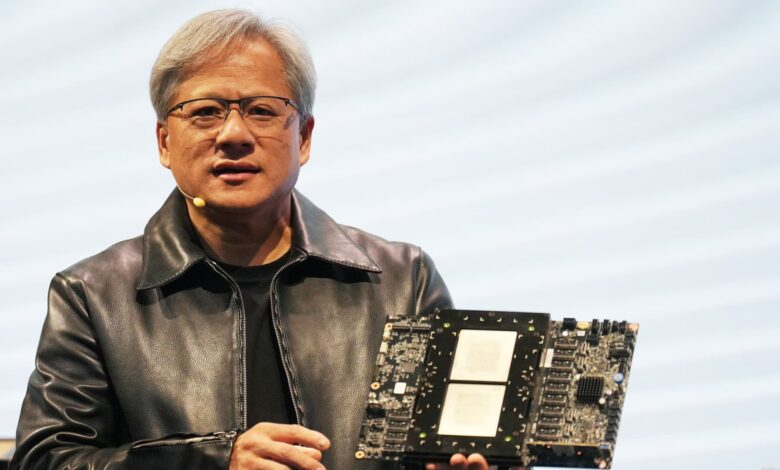Tech Giant Nvidia’s Breakthrough With ‘Superchips’ To Power AI Enhanced Performance; The Growing AI Chip Market Outlook $383.7 Billion By 2032
Nvidia, one of the leading technology giants, recently revealed its latest line of chips designed to power Artificial Intelligence (AI) advancements. The move is part of Nvidia's ongoing efforts to maintain its dominance in the highly competitive AI domain. The Artificial Intelligence Chip Market Research for 2032 showcases tremendous growth potential, with projections indicating substantial expansion. In 2022, starting from a value of $14.9 billion, the market is anticipated to reach an impressive $383.7 billion by 2032, indicating a strong compound annual growth rate (CAGR) of 38.2% from 2023 onward.

Aiming to solidify its dominance as the primary provider in the evolving and highly competitive AI domain, tech giant Nvidia has revealed its latest lineup of ‘Superchips’ designed to fuel the advancements in artificial intelligence.
During a developer conference in California, CEO Jensen Huang introduced the company’s new generation of graphics processors, emphasizing their pivotal role in driving generative AI technologies. Huang referred to these GPUs as essential components in the AI ecosystem.
The event, dubbed the “AI Woodstock” by Wedbush analyst Dan Ives, has emerged as a significant gathering in the tech industry, showcasing Nvidia’s unparalleled contribution to the AI revolution since the emergence of ChatGPT in late 2022.
In a packed arena typically reserved for sports and entertainment events, Huang jokingly reminded the audience that they were attending a developers’ conference, not a concert.

Nvidia’s powerful GPU chips and software play a crucial role in developing generative AI, outperforming competitors like AMD and Intel, and despite efforts by companies like Apple, Microsoft, and Amazon to develop their own AI-focused chips, they still rely on Nvidia’s products to fulfil their AI ambitions.
This key role in the AI revolution has led to Nvidia’s stock price up by approximately 250% in the past year, surpassing Amazon in market capitalization and trailing behind only Microsoft and Apple.
Nvidia also announced the release of even more potent processors and accompanying software under the Blackwell platform, thus continuing its momentum.
The Blackwell GPUs, named after David Blackwell, offer four times the speed of the previous generation in training AI models.
According to Nvidia, these chips also provide 25 times greater energy efficiency, addressing concerns about the energy-intensive nature of AI compared to conventional computing.
Unlike competitors such as Intel, Micron, and Texas Instruments, Nvidia, like AMD, relies on subcontractors like the Taiwan Semiconductor Manufacturing Co.
However, geopolitical tensions with Taiwan and China pose potential challenges, leading the US to prohibit Nvidia from supplying its most powerful chips to Chinese firms.
Nvidia also unveiled other AI initiatives, including Project Gr00t, a platform for training humanoid robots. Contrary to speculation, the project’s name is not inspired by the Guardians of the Galaxy character Groot.
It aims to create the world’s first human foundation model, enabling robots to learn from human demonstrations and mimic human behaviour.
Additionally, Nvidia announced collaboration with Apple to integrate AI capabilities into the Vision Pro spatial computing gear, ensuring Apple remains competitive in AI against rivals like Amazon, Google, Meta, and OpenAI.
Also, Nvidia introduced the Earth-2 Cloud Platform, utilizing AI supercomputers for predicting climate change through simulations.
The Great AI Chip Outpost
Research on the Artificial Intelligence Chip Market in 2032 reveals significant growth projections; valued at $14.9 billion in 2022, the market is anticipated to soar to $383.7 billion by 2032, demonstrating a remarkable compound annual growth rate (CAGR) of 38.2% from 2023 onwards.
Artificial Intelligence (AI) chips, specialized integrated circuits designed for efficient AI task execution, are at the forefront of this market expansion.
These are tailored for intricate algorithmic calculations, these chips leverage parallel processing, neural network architectures, and optimized memory structures to outperform general-purpose processors and are instrumental in driving AI technology forward, enabling real-time inference and training across diverse applications.
The practical applications of AI chips span a wide range of industries and functions.
For instance, in autonomous vehicles, they facilitate object identification, sensor data integration, and decision-making, enhancing safety and enabling self-driving capabilities.
In healthcare, AI chips analyze medical images from X-rays, MRIs, and CT scans, aiding in diagnoses.
At the same time, Language-related AI functions like voice recognition and translation benefit from AI chips, powering advancements in virtual assistants and language translation tools.
Likewise, AI chips optimize financial services through algorithmic trading, fraud detection, and risk assessment.
End-users of AI chips also include various sectors.
Tech companies integrate AI chips into products such as smartphones with AI-powered cameras and smart speakers with voice assistants, enhancing user experiences.
Enterprises utilize AI chips in data centers to train machine learning models and perform predictive analysis to refine business operations.
Research institutions and academia leverage AI chips to advance AI research, exploring novel algorithms and architectures.
The Last Bit, the prospect for AI chips is boundless, and consumers are likely to benefit from accelerated AI processing, experiencing improved products and services like tailored streaming recommendations and intelligent home automation.







